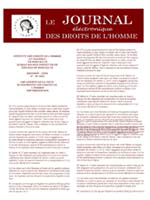|
|
|
|
|
NGO's & Human Rights Institutes |
|
HRIBB
INFORMATION
Robert Badinter : Pour prévenir un crime virtuel, la nouvelle justice de sûreté va détenir des hommes qui n'auront rien fait, au nom de leur dangerosité présumée la Halde juge les tests ADN "discriminatoires" The Event
60th Anniversary of the Universal Declaration of Human Rights 1948-2008 HUMAN RIGHTS IN
THEIR TEMPLE René CASSIN compared
the Universal Declaration to a Greek temple . Everyone knows this
picture that he himself drew and annotated by hand, (and which can now be found
in the French " Archives Nationales ") with a base
representing the general principles, liberty and equality provided by
articles 1 and 2 ; the square represented by the preamble; and then four
columns: the first one dedicated to "life, freedom and legal guarantees
given to human beings " organised by articles 3 to 11 of the
Universal Declaration , the second one that René CASSIN called
" the man and the woman in their social surroundings "
(articles 12 to 17), the third : " spiritual faculties, public
liberties and political rights " (articles 18 to 21) ;
the fourth : " the economic, social and cultural rights or duties
of the state towards human beings " (articles 22 to 27). And,
finally, directly laid on these four columns, without any architrave, frieze
or ledge, a fronton : " The links between human beings and the
society " (articles 28 to 30). As a warning
for the future, we cannot emphasise strongly enough that if civilised nations
agreed to proclaim to the entire world such fundamental principles ("
faith in fundamental human rights, in the dignity and worth of the human
person, in the equal rights of men and women ...", protection by
" the rules of law " or "social progress ",
that is to say essentially those rights that Antigone called "the
unchangeable unwritten laws of gods") as they emerged from the
Conference of SAN FRANCISCO in the "Charter of the United Nations",
whose 111 articles are widely cited in human rights matters (article 1 § 3,
article 55 C, article 56) then from the Universal Declaration, during the
spring of 1945), that is to say, at the very moment when the allied armies
had gone into concentration and extermination camps in Poland and Germany. And,
isn’t it symptomatic to see that at a time when the world, rocked by the revelation
or... by its guilty retrospective lack of curiosity, had discovered the ashes
of crematorium furnaces, its desire to protect human beings did not express
itself in a ruthless kind of vengeance or punishment, but in the will to
proclaim a protective universal system for all human beings even criminals,
in recognising "human dignity " (however absent from the
French Declaration of 1789) as one of the main rights for everyone and
" the highest aspiration of the common people " ? And also
that at that time, through article 11-1 of the Universal Declaration, an
attempt was made to promote the presumption of innocence – (already present
in article 9 of the French Declaration of 1789) - to the rank of a basic
principle of modern criminal law for all civilised nations ? Or that attempts
were made to establish the right to a "fair trial " which -
contrary to popular belief - is not an Anglo-Saxon conception of judicial
ceremony, but the very text of article 19 of René CASSIN’s first project. An anniversary is always the
opportunity of learning a lesson. Beyond their historic context, the
universal and indivisible human rights then proclaimed are today part of our
intangible legal heritage. But if they have been left as an inheritance to
all men, it is also with the obligation for them to know how to
"re-proclaim " them constantly but also to ensure the
safeguard of their substance and of their finality against the still subtler
and ever-present encroachments imposed by modern times. With an immoderate jingoism,
as far as foreigners are concerned, have we not too often laid claim to the
Universal Declaration? It would be fair to recall that beyond the important
role played by the United Nations’ Secretary, notably through the
instrumentality of the Canadian Professor John HUMPHREY, of such legal
specialists as the Lebanese reporter Charles MALIK, or of the Chinese
Vice-President, Dr CHANG (a true illustration of the universalist conception
of human rights),– who will remain among those known as "the giants "
of the Commission, the preparatory works demonstrate (and especially the
famous "first project ") that René Cassin can rightly be
called the "father of the Universal Declaration of Human Rights",
not forgetting that it also has a mother in the person of Mrs. Eleanor
ROOSEVELT, justifying the standing ovation received at the Palais de Chaillot
in Paris, 5O years ago, from the delegates after the adoption of the
Declaration. A homage must therefore be paid to these two great architects. Because
they have dreamed of this temple and have dedicated it to us, we appreciate
all the more on this 60th anniversary the fact that René CASSIN deserved
praise for such a temple, called " le Pantheon ", with a
stylobate, a square, columns and a pediment, but above all, the dome
masterfully designed by Soufflot, to show that the construction was perfectly
achieved. Bertrand FAVREAU Recent news in PDF format. To visualise
our Recent News in PDF format, you must have Acrobat Reader. This software is
available free of charge.
|

